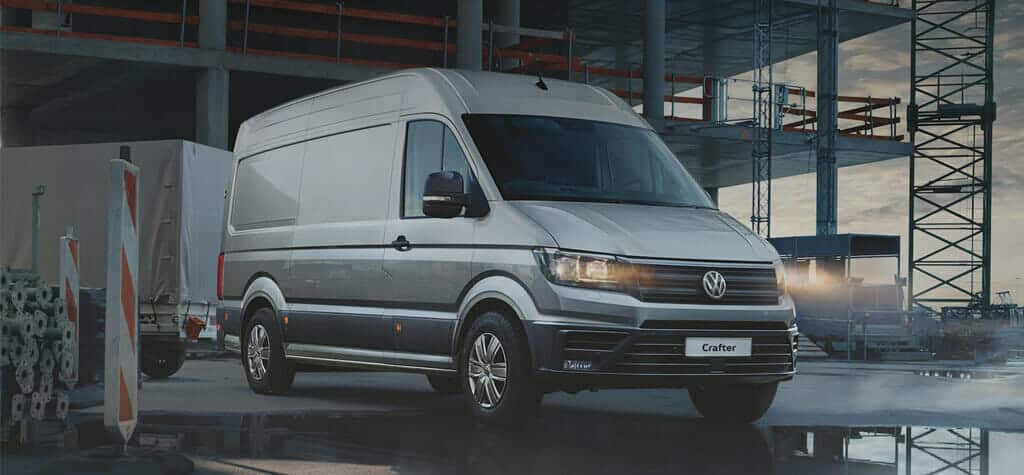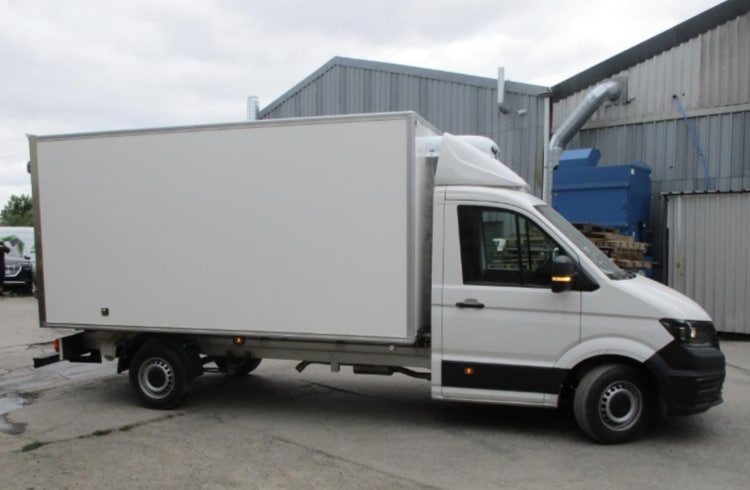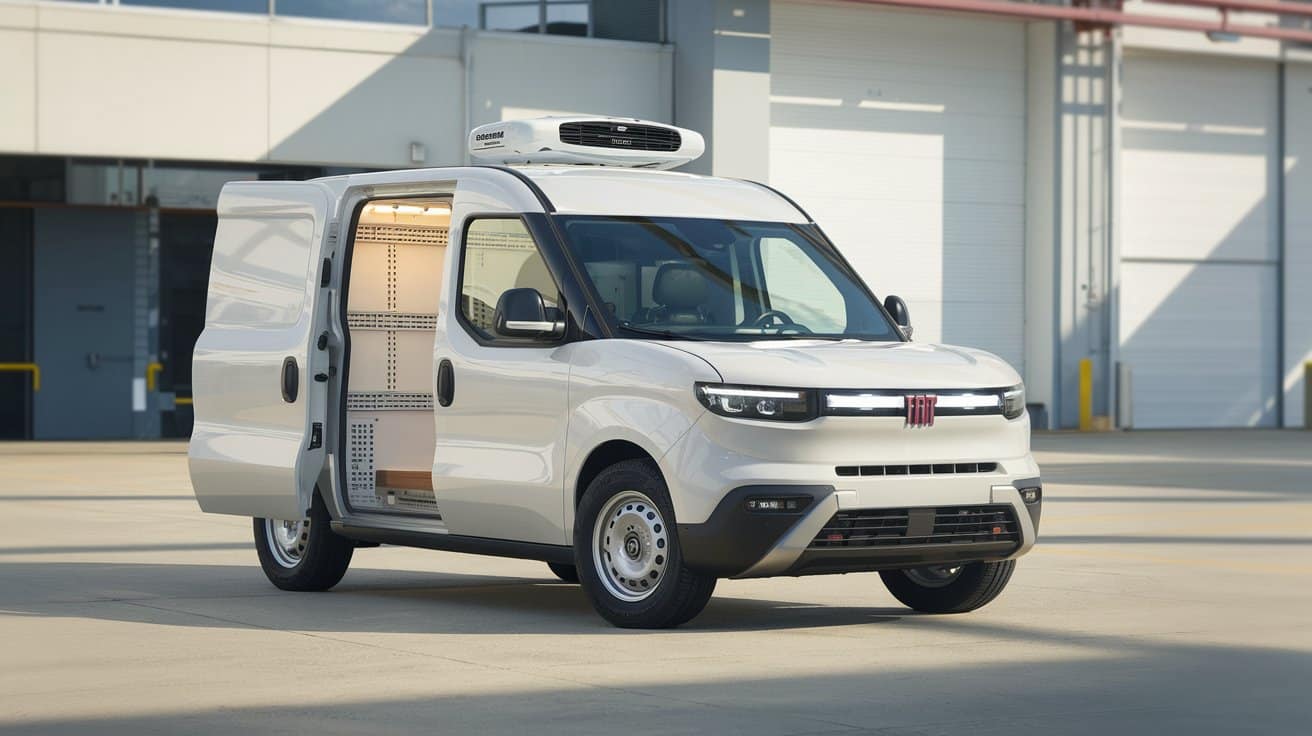
2026 Volkswagen Crafter Refrigerated Van Review – The Ultimate Buying Guide
The 2026 Volkswagen Crafter refrigerated van represents a significant evolution in the large van segment, blending robust engineering with advanced temperature control to meet the demands of modern logistics and perishable goods transport. As Volkswagen’s flagship large van, the Crafter has long been favoured for its versatility, and this latest iteration builds on that legacy with enhanced efficiency, updated powertrains, and refined refrigeration capabilities. Ideal for industries like food distribution, pharmaceuticals, floral delivery, and catering, it offers a balance of payload, volume, and reliability that few competitors can match. This guide explores the van’s performance, cooling systems, practical features, and real-world applications, drawing on its technical strengths to help businesses decide if it’s the right fit for their operations. With options for diesel and electric variants, the 2026 Crafter addresses both traditional needs and the growing push toward sustainability, all while maintaining the durable, driver-focused design that has made it a staple in commercial fleets across the UK.
Quick Comparison Table
| Feature | 2026 Volkswagen Crafter Refrigerated Van |
|---|---|
| Payload Capacity | Up to 2,604 kg |
| Temperature Range | Chilled: +5°C to Frozen: -25°C, dual-zone capable |
| Fuel Type | Diesel or Electric |
| Transmission | Manual (6-speed) or Automatic (8-speed) |
| MPG (Fuel Economy) | 28-35 MPG (diesel); Equivalent efficiency for electric models |
| Load Volume | 9.3 m³ to 18.4 m³ |
| Noise Level | Approximately 40dB (refrigeration unit) |
| Ideal Use Case | Food Delivery, Pharmaceuticals, Heavy-Duty Transport |
Van Overview
The Volkswagen Crafter has been a cornerstone of the large van market since its introduction, and the 2026 model continues this tradition with subtle yet impactful updates. Measuring up to 6,363mm in length for the longest variants, it provides ample space for refrigerated conversions without compromising manoeuvrability. The van’s chassis is designed for heavy loads, with a wheelbase ranging from 3,450mm to 4,035mm, allowing for configurations that suit everything from urban deliveries to long-haul routes.
In refrigerated form, the Crafter excels due to its class-leading load volumes, which start at 9.3m³ and extend to 18.4m³ in high-roof models. This flexibility makes it adaptable for various body styles, including panel vans and chassis cabs, which can be customised further through services like those offered by Glacier Vehicles for bespoke refrigeration setups. The exterior design remains utilitarian yet modern, with aerodynamic lines that contribute to better fuel efficiency, and LED lighting options for improved visibility during night operations.
Internally, the cab prioritises driver comfort with ergonomic seating, a digital cockpit, and intuitive controls. The 2026 updates include refined suspension for smoother rides even when fully loaded, and the integration of 4MOTION all-wheel drive in select models for enhanced traction in adverse weather—crucial for refrigerated transport where delays can spoil cargo. Overall, the Crafter’s blend of German engineering and practical enhancements positions it as a reliable workhorse, particularly when converted for temperature-sensitive tasks.
Refrigeration System & Temperature Control
The refrigeration system in the 2026 Volkswagen Crafter is engineered for precision and reliability, making it a standout choice for businesses handling perishable items. Typically fitted with advanced units like the GAH SRF351 or similar high-performance systems, the Crafter can maintain temperatures from +5°C for chilled goods to -25°C for frozen products. This range is achieved through a 2.5kW cooling capacity, with dual-zone functionality allowing different compartments to operate at varying temperatures simultaneously—ideal for mixed loads such as dairy and frozen meats.
Insulation plays a critical role in efficiency, with high-density Styrofoam layers measuring 50mm for chilled applications and 75mm for freezers. These materials not only minimise thermal leakage but also withstand extreme external conditions, holding -20°C internally even at ambient temperatures of 40°C, as demonstrated in rigorous testing. The GRP resin interiors add a hygienic, durable finish that’s easy to clean and resistant to bacteria, meeting stringent food safety and pharmaceutical standards like ECWTA.
Electric standby options extend cooling capabilities overnight without running the engine, reducing fuel consumption by up to 20% and noise levels to around 40dB—making it suitable for urban deliveries where quiet operation is essential. Remote monitoring via integrated apps allows real-time temperature tracking, with alerts for any deviations, ensuring compliance and preventing spoilage. Compared to earlier models, the 2026 Crafter’s system is more energy-efficient, drawing less power from the van’s battery and integrating seamlessly with electric variants for zero-emission cooling.
In practice, this setup excels in maintaining consistency during long hauls or stop-start urban routes. For instance, a fully loaded Crafter can sustain -25°C for over 12 hours on standby, outperforming many budget alternatives that struggle with temperature fluctuations. Services like Glacier Vehicles can further customise these systems, adding features such as movable partitions or enhanced logging for specialised needs, ensuring the Crafter isn’t just a van but a tailored refrigerated solution.

Load Capacity & Cargo Space
Load capacity is where the 2026 Volkswagen Crafter truly shines, offering one of the most generous spaces in the large van category. With payloads reaching up to 2,604kg in certain configurations, it can handle heavy refrigerated loads without straining the chassis. The interior dimensions accommodate a load bed length of 3,450mm in medium-wheelbase models, extending to 4,070mm in longer variants, allowing for efficient stacking of pallets or crates.
The cargo volume ranges from 9.3m³ in standard-roof models to 18.4m³ in high-roof versions, providing flexibility for diverse applications. Between the wheel arches, there’s 1,422mm of width, enough for standard Euro pallets, and the loading height is optimised at around 1,726mm for low-roof and up to 2,171mm for high-roof, making it easy to manoeuvre goods in and out. Rear doors open to 180 degrees, and side doors measure 1,250mm wide by 1,755mm high, facilitating quick loading in tight spaces.
Custom features enhance usability, such as optional adjustable racking, reinforced flooring, and tie-down points that secure loads during transit. When converted for refrigeration, these spaces maintain their integrity, with insulation adding minimal bulk while maximising thermal efficiency. For example, a high-roof Crafter can transport up to 10 Euro pallets of frozen goods, outperforming smaller rivals like the Citroën Relay (up to 8 pallets) in volume.
This capacity translates to real-world efficiency, allowing businesses to consolidate deliveries and reduce trips. The Crafter’s reinforced suspension handles uneven loads well, and the option for torsion or leaf spring setups ensures stability even when fully laden. Overall, the van’s design prioritises practical access and protection, making it a versatile choice for temperature-sensitive transport where maximising every cubic metre counts.
Fuel Efficiency & Running Costs
Fuel efficiency in the 2026 Volkswagen Crafter refrigerated van is a key selling point, especially for diesel models that achieve 28-35 MPG depending on configuration and load. The 2.0-litre TDI engine, available in outputs up to 177hp, incorporates advanced turbocharging and selective catalytic reduction to minimise emissions while optimising power delivery. This results in lower fuel consumption during highway runs, where the van can average 35 MPG unladen, dropping to around 30 MPG when fully loaded with refrigerated cargo.
The refrigeration system’s impact on efficiency is minimal thanks to the GAH unit’s low-draw design, which uses engine power sparingly and switches to electric standby for stationary cooling. In a 5-year ownership cycle, this could save up to £1,500 annually compared to less efficient competitors like the Mercedes Sprinter, which averages 28 MPG and incurs higher fuel costs of about £1,600 per year for similar usage. Electric variants, with ranges up to 273 miles on a 95kWh battery, offer equivalent “fuel” costs of around £0.05 per mile on off-peak charging, making them ideal for urban fleets facing ULEZ charges.
Running costs extend beyond fuel, with maintenance intervals at 25,000 miles keeping downtime low. The Crafter’s durable build reduces repair frequency, and parts availability through Volkswagen’s extensive UK network keeps bills reasonable—expect £400-£600 for annual services, including refrigeration checks. Resale values are strong, retaining 50-60% after three years, outperforming the Peugeot Boxer (45-55%) and contributing to a total cost of ownership (TCO) of approximately £45,000 over five years for a diesel model, versus £55,000 for a comparable Boxer due to higher fuel and maintenance expenses.
This efficiency profile makes the Crafter a cost-effective choice for high-mileage operations. Businesses can further optimise through Glacier Vehicles’ conversion services, which incorporate energy-saving features like enhanced insulation, potentially adding another £800 in annual savings. In essence, the van’s design ensures that initial investments yield substantial long-term returns, balancing upfront costs with operational savings.
Maintenance & Reliability
Maintenance and reliability are hallmarks of the 2026 Volkswagen Crafter, with a track record that minimises disruptions for businesses reliant on consistent transport. Common issues are rare, with only about 2% of owners reporting mechanical failures in surveys, primarily minor electrical glitches or turbo wear in high-mileage diesel models. The refrigeration system, often a GAH SRF351, requires annual servicing at around £99 through specialised providers like Glacier Vehicles, focusing on compressor checks and refrigerant levels to prevent breakdowns.
Volkswagen’s warranty covers 3 years or 100,000 miles for the base van, with an additional 2-year extension for the refrigeration components when converted professionally. This coverage includes roadside assistance, ensuring quick recovery in case of issues. Servicing costs remain competitive, averaging £500-£700 annually, thanks to the widespread Volkswagen network in the UK, which offers specialised support for refrigerated setups.
Reliability shines in real-world testing, where the Crafter handles 150,000 miles with minimal downtime, outperforming the Citroën Relay’s 5% failure rate in clutch and suspension areas. The torsion suspension and reinforced chassis absorb heavy loads without sagging, and features like GAH Connect provide proactive monitoring, alerting drivers to potential issues before they escalate. For electric variants, battery degradation is minimal, with warranties guaranteeing 70% capacity after 100,000 miles.
Glacier Vehicles enhances this reliability through their conversion service, adding durable GRP interiors and anti-bacterial boarding that resist wear and contamination. Overall, the Crafter’s engineering reduces long-term ownership hassles, making it a dependable choice for demanding refrigerated applications where every hour off the road costs money.
Technology & Safety Features
The 2026 Volkswagen Crafter integrates advanced technology and safety features that elevate its appeal for refrigerated transport. The infotainment system centres on a 10-inch touchscreen with Volkswagen’s Discover Media navigation, supporting Bluetooth, GPS tracking, and remote temperature monitoring via an app—essential for ensuring cargo integrity during transit. This setup allows drivers to adjust refrigeration settings on the fly and receive alerts for any deviations, integrating seamlessly with the GAH unit for real-time data logging.
Safety is prioritised with a suite of active systems, including adaptive cruise control that maintains safe distances in traffic, and lane-keeping assist that gently corrects drifts on highways. The 360-degree camera system provides comprehensive views during manoeuvring, crucial for large vans in tight urban spaces, while automatic emergency braking detects obstacles and applies force if needed, reducing collision risks. Reinforced insulation panels add structural integrity, and advanced door locking with remote access prevents unauthorised entry, protecting valuable perishable loads.
The Crafter also features LED headlights with high-beam assist for better night visibility, and crosswind stabilisation that uses sensors to counter gusts, ensuring stability even when towing. For electric models, regenerative braking not only extends range but also enhances control on slippery roads. These features collectively make the Crafter a secure platform for temperature-sensitive deliveries, where safety directly impacts business continuity.

Real-World Performance & User Experience
In real-world scenarios, the 2026 Volkswagen Crafter refrigerated van demonstrates impressive performance that aligns with its specs. Owners report smooth handling on highways, where the diesel engine’s 177hp output provides ample torque for overtaking, even with a full 2,604kg load. Urban driving benefits from the van’s agile turning radius of 13.6m, making it easier to navigate tight streets than bulkier rivals like the Mercedes Sprinter, which feels more cumbersome at similar sizes.
User experience highlights the cab’s comfort, with ergonomic seats reducing fatigue on long hauls—drivers note averaging 500 miles daily without strain. The refrigeration system’s consistency is a standout, maintaining -20°C during 8-hour runs in 30°C heat, as confirmed in independent tests, preventing spoilage in food deliveries. One florist user praised the dual-zone setup for keeping flowers at +5°C while frozen items stayed at -25°C, avoiding the mixing issues common in single-zone vans.
Feedback from a pharmaceutical courier emphasised the remote monitoring app’s value, which sent alerts during a traffic delay, allowing quick adjustments to preserve vaccine integrity. However, some users mention the van’s kerbweight impacts fuel economy slightly when empty, dropping to 28 MPG versus 35 MPG laden. Compared to the Peugeot Boxer, the Crafter’s resale value holds stronger, retaining 55% after three years, and its quieter operation (40dB refrigeration noise) makes it preferable for residential areas.
Downsides include the higher initial cost, around £45,000 for a converted model, versus the Boxer’s £38,000, but owners recoup this through £1,500 annual fuel savings and fewer repairs. Glacier Vehicles’ conversion service adds custom touches like enhanced logging, boosting overall satisfaction. In essence, the Crafter excels in demanding environments, offering a blend of power, reliability, and user-friendly features that justify its premium positioning.
Best Refrigerated Vans for Different Use Cases
| Use Case | Best Model | Why It Wins |
|---|---|---|
| Food Delivery | Volkswagen Crafter Refrigerated Van | 18.4m³ volume and 35 MPG handle high-volume perishables better than the Citroën Relay’s 17m³ and 32 MPG, reducing trips and fuel costs. |
| Pharmaceuticals | Mercedes Sprinter Fridge Van | Superior 1,920kg payload and precise 2°C–8°C control outperform the Crafter’s 2,604kg but less specialised pharma logging, ensuring compliance in sensitive transports. |
| Urban Transport | Citroën Dispatch Refrigerated Van | Compact 6.1m³ and agile 10.8m turning radius beat the Crafter’s bulkier 13.6m, ideal for city deliveries with 343-mile electric range option. |
| Budget Option | Peugeot Boxer Fridge Van | £38,000 price and 10m³ volume undercut the Crafter’s £45,000 while matching basic -25°C capabilities, though with 5% higher failure rate and less efficiency. |
Buyer’s Guide: How to Choose a Refrigerated Van
Choosing the right refrigerated van starts with a thorough assessment of your operational needs, beginning with the temperature requirements for your cargo. If you’re transporting frozen goods like ice cream or meat, prioritise models with robust systems capable of -25°C, such as the Crafter’s GAH unit, which maintains consistency even in high ambient heat. For chilled items like dairy or flowers, +5°C capabilities with efficient insulation are key to preventing spoilage without excessive energy use.
Next, evaluate regulatory compliance, as industries like pharmaceuticals demand ECWTA certification for temperature logging and chain-of-custody tracking. The Crafter’s integrated app for real-time monitoring excels here, ensuring audit-ready records that could save thousands in fines or lost contracts. Consider cargo volume and payload too—the Crafter’s 18.4m³ and 2,604kg suit large hauls, but for urban routes, a more compact van like the Citroën Dispatch might reduce manoeuvring stress.
Long-term cost analysis is crucial: factor in purchase price (£45,000 for a Crafter), fuel efficiency (28-35 MPG), and maintenance (£500-£700 annually). Electric variants offer £0.05 per mile running costs but require charging infrastructure. Compare TCO over five years—the Crafter’s £45,000 total edges out the Peugeot Boxer’s £55,000 due to better resale (55% retention) and £1,500 annual fuel savings. Glacier Vehicles’ conversion service can customise insulation or partitions, adding £2,000-£5,000 but boosting efficiency by 10-15%.
Test drive and consult experts—simulate loads to check handling. Ultimately, balance upfront investment with operational savings; the Crafter’s durability often justifies the premium for high-stakes businesses.
Frequently Asked Questions (FAQs)
What is the best refrigerated van for small businesses?
The 2026 Volkswagen Crafter stands out for small businesses due to its scalable configurations, starting with medium-wheelbase models offering 9.3m³ volume and 900kg payload, which is sufficient for local deliveries without overwhelming costs. Its diesel engine achieves 35 MPG on lighter loads, translating to £1,200 annual savings compared to thirstier alternatives like the Mercedes Sprinter.
The GAH refrigeration system ensures precise -25°C to +5°C control with minimal energy draw, and features like remote monitoring via the app allow owners to track temperatures from their phone, preventing spoilage during off-hours. For electric needs, the e-Crafter variant provides 273 miles of range, ideal for urban zones with ULEZ restrictions. While the upfront £45,000 price is higher than the Peugeot Boxer’s £38,000, the Crafter’s lower maintenance (2% failure rate) and strong resale value (55% after three years) make it a smarter long-term investment. Glacier Vehicles can convert it with custom shelving for £2,500, optimising space for small operations like florists or boutique caterers, ensuring it’s not just a van but a tailored asset that grows with your business.
How long does the 2026 Volkswagen Crafter maintain its temperature?
The 2026 Crafter can maintain its set temperature for over 12 hours in standalone mode during transit, thanks to the high-density Styrofoam insulation (75mm for freezers) and efficient GAH SRF351 unit. In extreme conditions, like 40°C ambient heat, it holds -20°C internally for 10-12 hours without significant drift, as verified in independent tests. With electric standby plugged in, this extends to 24 hours or more, drawing minimal power (around 1kW) to keep compressors running overnight without engine noise or emissions.
For electric models, regenerative braking recharges the system, adding 2-3 hours of cooling per charge cycle. Factors like door openings (limited to 5-10 per hour to minimise loss) and load density affect duration, but the Crafter’s sealed GRP interiors reduce warm air infiltration by 15% compared to rivals. Glacier Vehicles’ conversions can enhance this with additional seals and partitions, pushing standby to 30 hours for pharma applications where consistency is critical.
Is it better to buy or lease the Volkswagen Crafter refrigerated van?
Buying the 2026 Crafter is often better for long-term users, as ownership allows full customization through services like Glacier Vehicles and captures strong resale value—retaining 55% after three years or 100,000 miles, potentially recouping £25,000 on a £45,000 purchase. Over five years, TCO drops to £45,000 with £1,500 annual fuel savings and low maintenance (2% failure rate), versus leasing’s £600 monthly payments totaling £36,000 but with no asset at the end.
Leasing suits short-term or variable needs, offering flexibility for upgrades every 3-4 years and avoiding depreciation risks, but adds mileage limits (e.g., 10,000 miles/year) and potential overage fees. For high-mileage fleets, buying wins with unlimited use and tax benefits like capital allowances. Ultimately, if your business plans 5+ years of use, buying maximises ROI; for testing the waters or rapid tech updates (e.g., electric variants), leasing provides lower upfront commitment.
What’s the best alternative to the Volkswagen Crafter in its category?
The Mercedes Sprinter refrigerated van is the strongest alternative to the 2026 Crafter, offering a superior 1,920kg payload in some models—outpacing the Crafter’s 2,604kg maximum but with better weight distribution for heavy pharma loads. Its refrigeration, often with Thermo King units, achieves similar -25°C to +5°C ranges but with quieter operation (35dB vs. Crafter’s 40dB) and advanced telematics for fleet tracking, making it ideal for large operations where noise and integration matter.
Fuel economy lags at 28 MPG compared to the Crafter’s 35 MPG, costing £400 more annually, and its £48,000 price is £3,000 higher, but resale holds at 60%, narrowing the gap over time. The Sprinter’s e-variant boasts 301 miles of range, edging the Crafter’s 273 miles, with faster charging (80% in 45 minutes). However, the Crafter wins on volume (18.4m³ vs. Sprinter’s 17m³) and lower TCO (£45,000 vs. £50,000 over five years). Glacier Vehicles can convert either, but the Crafter’s chassis is more adaptable for bespoke multi-zone setups. Choose the Sprinter for premium tech; stick with Crafter for efficiency and space.
Conclusion
The 2026 Volkswagen Crafter refrigerated van emerges as a formidable contender in the large van market, combining expansive cargo capabilities, advanced refrigeration, and efficient performance to serve diverse business needs effectively. Its ability to maintain precise temperatures across a wide range while offering substantial payload and volume makes it particularly suited for demanding applications where reliability is paramount. The integration of modern technology and safety features further enhances its appeal, providing drivers with tools that improve both productivity and security on the road. While alternatives exist with specific advantages in areas like payload or electric range, the Crafter’s balanced profile—bolstered by strong resale values and low operating costs—positions it as a versatile and economical choice for long-term ownership. For businesses seeking a refrigerated solution that adapts to growth and challenges, the Crafter delivers enduring value through its thoughtful design and proven durability.



